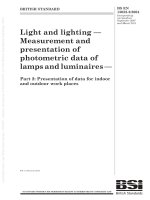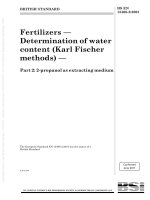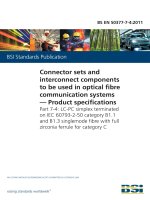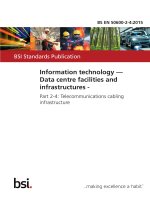Bsi bs en 61988 2 4 2011
Bạn đang xem bản rút gọn của tài liệu. Xem và tải ngay bản đầy đủ của tài liệu tại đây (1.52 MB, 42 trang )
BS EN 61988-2-4:2011
BSI Standards Publication
Plasma display panels
Part 2-4: Measuring methods — Visual
quality: Image artifacts
BS EN 61988-2-4:2011
BRITISH STANDARD
National foreword
This British Standard is the UK implementation of EN
61988-2-4:2011. It is identical to IEC 61988-2-4:2011.
The UK participation in its preparation was entrusted to Technical
Committee EPL/47, Semiconductors.
A list of organizations represented on this committee can be
obtained on request to its secretary.
This publication does not purport to include all the necessary
provisions of a contract. Users are responsible for its correct
application.
© BSI 2011
ISBN 978 0 580 60615 1
ICS 31.260
Compliance with a British Standard cannot confer immunity from
legal obligations.
This British Standard was published under the authority of the
Standards Policy and Strategy Committee on 31 October 2011.
Amendments issued since publication
Date
Text affected
BS EN 61988-2-4:2011
EUROPEAN STANDARD
EN 61988-2-4
NORME EUROPÉENNE
EUROPÄISCHE NORM
October 2011
ICS 31.260
English version
Plasma display panels Part 2-4: Measuring methods Visual quality: Image artifacts
(IEC 61988-2-4:2011)
Panneaux d'affichage à plasma Partie 2-4: Méthodes de mesure Qualité visuelle: Artéfacts d'image
(CEI 61988-2-4:2011)
Plasmabildschirme Teil 2-4: Messverfahren Visuelle Qualität: Bild-Artefakte
(IEC 61988-2-4:2011)
This European Standard was approved by CENELEC on 2011-09-29. CENELEC members are bound to comply
with the CEN/CENELEC Internal Regulations which stipulate the conditions for giving this European Standard
the status of a national standard without any alteration.
Up-to-date lists and bibliographical references concerning such national standards may be obtained on
application to the CEN-CENELEC Management Centre or to any CENELEC member.
This European Standard exists in three official versions (English, French, German). A version in any other
language made by translation under the responsibility of a CENELEC member into its own language and notified
to the CEN-CENELEC Management Centre has the same status as the official versions.
CENELEC members are the national electrotechnical committees of Austria, Belgium, Bulgaria, Croatia, Cyprus,
the Czech Republic, Denmark, Estonia, Finland, France, Germany, Greece, Hungary, Iceland, Ireland, Italy,
Latvia, Lithuania, Luxembourg, Malta, the Netherlands, Norway, Poland, Portugal, Romania, Slovakia, Slovenia,
Spain, Sweden, Switzerland and the United Kingdom.
CENELEC
European Committee for Electrotechnical Standardization
Comité Européen de Normalisation Electrotechnique
Europäisches Komitee für Elektrotechnische Normung
Management Centre: Avenue Marnix 17, B - 1000 Brussels
© 2011 CENELEC -
All rights of exploitation in any form and by any means reserved worldwide for CENELEC members.
Ref. No. EN 61988-2-4:2011 E
BS EN 61988-2-4:2011
EN 61988-2-4:2011
-2-
Foreword
The text of document 110/260/CDV, future edition 1 of IEC 61988-2-4, prepared by IEC TC 110, "Flat
panel display devices", was submitted to the IEC-CENELEC parallel vote and approved by CENELEC as
EN 61988-2-4:2011.
The following dates are fixed:
•
•
latest date by which the document has
to be implemented at national level by
publication of an identical national
standard or by endorsement
latest date by which the national
standards conflicting with the
document have to be withdrawn
(dop)
2012-06-29
(dow)
2014-09-29
Attention is drawn to the possibility that some of the elements of this document may be the subject of
patent rights. CENELEC [and/or CEN] shall not be held responsible for identifying any or all such patent
rights.
Endorsement notice
The text of the International Standard IEC 61988-2-4:2011 was approved by CENELEC as a European
Standard without any modification.
In the official version, for Bibliography, the following notes have to be added for the standards indicated:
IEC 61747-6:2004
NOTE Harmonized as EN 61747-6:2004 (not modified).
IEC 61747-6-3:2011
NOTE Harmonized as EN 61747-6-3:2011 (not modified).
BS EN 61988-2-4:2011
-3-
EN 61988-2-4:2011
Annex ZA
(normative)
Normative references to international publications
with their corresponding European publications
The following referenced documents are indispensable for the application of this document. For dated
references, only the edition cited applies. For undated references, the latest edition of the referenced
document (including any amendments) applies.
NOTE When an international publication has been modified by common modifications, indicated by (mod), the relevant EN/HD
applies.
Publication
Year
Title
EN/HD
Year
1)
IEC 60068-1
+ corr. October
1988
1988
Environmental testing Part 1: General and guidance
EN 60068-1
1994
IEC 60107-1
1997
Methods of measurement on receivers for
EN 60107-1
television broadcast transmissions Part 1: General considerations Measurements at radio and video frequencies
1997
IEC 61988-1
2003
Plasma display panels Part 1: Terminology and letter symbols
EN 61988-1
2003
IEC 61988-2-1
2002
Plasma display panels Part 2-1: Measuring methods - Optical
EN 61988-2-1
2002
IEC 61988-2-2
2003
Plasma display panels EN 61988-2-2
Part 2-2: Measuring methods - Optoelectrical
2003
CIE 15
2004
Colorimetry
-
1)
EN 60068-1 includes A1 to IEC 60068-1 + corr. October .
2)
EN 61988-1 is superseded by EN 61988-1:2011, which is based on IEC 61988-1:2011.
2)
-
BS EN 61988-2-4:2011
–2–
61988-2-4 © IEC:2011
CONTENTS
FOREWORD ........................................................................................................................... 4
1
Scope ............................................................................................................................... 6
2
Normative references ....................................................................................................... 6
3
Terms and definitions ....................................................................................................... 6
4
Structure of measuring equipment .................................................................................... 7
5
Standard measuring conditions ......................................................................................... 8
6
5.1 General ................................................................................................................... 8
5.2 Adjustment of PDP modules .................................................................................... 8
Measuring methods .......................................................................................................... 8
6.1
6.2
6.3
6.4
Annex A
Viewing angle .......................................................................................................... 8
6.1.1 Purpose ....................................................................................................... 8
6.1.2 Equipment ................................................................................................... 8
6.1.3 Measuring equipment setup ......................................................................... 8
6.1.4 Measuring method of half luminance viewing angle ..................................... 9
6.1.5 Measuring method of half contrast viewing angle ....................................... 10
6.1.6 Measuring method of 10:1 Contrast ratio viewing angle ............................. 11
6.1.7 Measuring method of colour viewing angle ................................................ 12
Image streaking ..................................................................................................... 13
6.2.1 Purpose ..................................................................................................... 13
6.2.2 Equipment ................................................................................................. 13
6.2.3 Measuring method of image streaking ....................................................... 13
Flicker ................................................................................................................... 17
6.3.1 Purpose ..................................................................................................... 17
6.3.2 Equipment ................................................................................................. 17
6.3.3 Measuring method of flicker ....................................................................... 17
Moving picture resolution ...................................................................................... 19
6.4.1 General ..................................................................................................... 19
6.4.2 Subjective measuring method of Moving Picture Resolution ...................... 20
6.4.3 Objective measuring method of moving picture resolution .......................... 22
(informative) Simulation method of moving picture resolution ................................. 27
Annex B (informative) Technical description on moving picture resolution ............................ 32
Bibliography .......................................................................................................................... 35
Figure 1 – Measuring equipment setup and example of measuring results for
horizontal and vertical viewing angles ..................................................................................... 9
Figure 2 – Low APL image streaking patterns and measuring points ..................................... 15
Figure 3 – High APL image streaking patterns and measuring points .................................... 16
Figure 4 – Measuring systems and its arrangement .............................................................. 18
Figure 5 – Flicker sensitivity curve ........................................................................................ 18
Figure 6 – Measured luminance frequency spectrum............................................................. 19
Figure 7 – Image pattern for the evaluation of resolution ....................................................... 22
Figure 8 – Peak level and amplitude of the test signal .......................................................... 24
Figure 9 – Example of captured image .................................................................................. 25
Figure 10 – Example of Fourier transform ............................................................................. 25
Figure 11 – Example of limit resolution evaluation ................................................................ 26
BS EN 61988-2-4:2011
61988-2-4 © IEC:2011
–3–
Figure A.1 – The simulation principle of motion artifacts for a 5-bit binary subfield
arrangement ......................................................................................................................... 28
Figure A.2 – Set-up to measure the temporal step response ................................................. 29
Figure A.3 – Simulation of modulation transfer function (MTF) at the different special
frequencies ........................................................................................................................... 31
Figure B.1 – Example of sub-sampling .................................................................................. 33
Figure B.2 – Effect of the sub-sampling method and 0,5 ppf motion in the resolution ............ 34
Table 1 – Example of half luminance viewing angle .............................................................. 10
Table 2 – Example of half contrast viewing angle .................................................................. 11
Table 3 – Example of 10:1 contrast ratio viewing angle ......................................................... 12
Table 4 – Example of colour viewing angle ........................................................................... 13
Table 5 – Example of image streaking ratio report ................................................................ 17
Table 6 – Flicker level report table ........................................................................................ 19
Table 7 – Comparison of units for moving speed ................................................................... 21
BS EN 61988-2-4:2011
–4–
61988-2-4 © IEC:2011
INTERNATIONAL ELECTROTECHNICAL COMMISSION
_____________
PLASMA DISPLAY PANELS –
Part 2-4: Measuring methods –
Visual quality: Image artifacts
FOREWORD
1) The International Electrotechnical Commission (IEC) is a worldwide organization for standardization comprising
all national electrotechnical committees (IEC National Committees). The object of IEC is to promote
international co-operation on all questions concerning standardization in the electrical and electronic fields. To
this end and in addition to other activities, IEC publishes International Standards, Technical Specifications,
Technical Reports, Publicly Available Specifications (PAS) and Guides (hereafter referred to as “IEC
Publication(s)”). Their preparation is entrusted to technical committees; any IEC National Committee interested
in the subject dealt with may participate in this preparatory work. International, governmental and nongovernmental organizations liaising with the IEC also participate in this preparation. IEC collaborates closely
with the International Organization for Standardization (ISO) in accordance with conditions determined by
agreement between the two organizations.
2) The formal decisions or agreements of IEC on technical matters express, as nearly as possible, an international
consensus of opinion on the relevant subjects since each technical committee has representation from all
interested IEC National Committees.
3) IEC Publications have the form of recommendations for international use and are accepted by IEC National
Committees in that sense. While all reasonable efforts are made to ensure that the technical content of IEC
Publications is accurate, IEC cannot be held responsible for the way in which they are used or for any
misinterpretation by any end user.
4) In order to promote international uniformity, IEC National Committees undertake to apply IEC Publications
transparently to the maximum extent possible in their national and regional publications. Any divergence
between any IEC Publication and the corresponding national or regional publication shall be clearly indicated in
the latter.
5) IEC itself does not provide any attestation of conformity. Independent certification bodies provide conformity
assessment services and, in some areas, access to IEC marks of conformity. IEC is not responsible for any
services carried out by independent certification bodies.
6) All users should ensure that they have the latest edition of this publication.
7) No liability shall attach to IEC or its directors, employees, servants or agents including individual experts and
members of its technical committees and IEC National Committees for any personal injury, property damage or
other damage of any nature whatsoever, whether direct or indirect, or for costs (including legal fees) and
expenses arising out of the publication, use of, or reliance upon, this IEC Publication or any other IEC
Publications.
8) Attention is drawn to the Normative references cited in this publication. Use of the referenced publications is
indispensable for the correct application of this publication.
9) Attention is drawn to the possibility that some of the elements of this IEC Publication may be the subject of
patent rights. IEC shall not be held responsible for identifying any or all such patent rights.
International Standard IEC 61988-2-4 has been prepared by IEC technical committee 110:
Flat panel display devices.
The text of this standard is based on the following documents:
FDIS
Report on voting
110/260/CDV
110/297/RVC
Full information on the voting for the approval on this standard can be found in the report on
voting indicated in the above table.
This publication has been drafted in accordance with the ISO/IEC Directives, Part 2.
A list of all the parts in the IEC 61988 series, under the general title Plasma display panels,
can be found on the IEC website.
BS EN 61988-2-4:2011
61988-2-4 © IEC:2011
–5–
The committee has decided that the contents of this publication will remain unchanged until
the stability date indicated on the IEC web site under "" in the data
related to the specific publication. At this date, the publication will be
•
•
•
•
reconfirmed,
withdrawn,
replaced by a revised edition, or
amended.
IMPORTANT – The 'colour inside' logo on the cover page of this publication indicates
that it contains colours which are considered to be useful for the correct
understanding of its contents. Users should therefore print this document using a
colour printer.
BS EN 61988-2-4:2011
–6–
61988-2-4 © IEC:2011
PLASMA DISPLAY PANELS –
Part 2-4: Measuring methods –
Visual quality: Image artifacts
1
Scope
This part of IEC 61988 determines the measuring methods for characterizing the performance
of plasma display panel (PDP) modules in the following areas:
a) viewing angle;
b) image streaking;
c) flicker;
d) moving picture resolution.
2
Normative references
The following referenced documents are indispensable for the application of these standards.
For standards with explicit dates, only the edition cited applies. For standards references, the
latest edition of the referenced standard (including any amendments) applies.
IEC 60068-1:1988, Environmental testing – Part 1: General and guidance
IEC 60107-1:1997, Methods of measurement on receivers for television broadcast
transmissions – Part 1: General considerations – Measurements at radio and video
frequencies
IEC 61988-1:2003, Plasma display panels – Part 1: Terminology and letter symbols
IEC 61988-2-1:2002, Plasma display panels – Part 2-1: Measuring methods – Optical
IEC 61988-2-2:2003, Plasma display panels – Part 2-2: Measuring methods – Optoelectrical
CIE 15:2004, Colorimetry, 3rd Edition
3
Terms and definitions
For the purposes of this document, the terms and definitions given in IEC 61988-1,
IEC 60068-1, and IEC 60107-1, as well as the following apply.
3.1
viewing angle
angular range over which a display can be viewed with acceptable specified visual
performance
NOTE This document specifies two types of viewing angle regarding the viewing direction, such as horizontal and
vertical.
3.2
half luminance viewing angle
viewing angle over which the luminance is equal or higher than half of the luminance
measured at the angle perpendicular to the screen
BS EN 61988-2-4:2011
61988-2-4 © IEC:2011
–7–
3.3
half contrast viewing angle
viewing angle over which the contrast ratio is equal or higher than half of the contrast ratio
measured at the angle perpendicular to the screen
3.4
10:1 contrast ratio viewing angle
viewing angle over which the contrast ratio is equal or higher than 10:1
3.5
colour viewing angle
viewing angle over which the chromaticity shift Δ(u',v') is equal or less than specified
threshold value
3.6
image streaking
variance in luminance with changing vertical or horizontal line load
3.7
flicker
unintended but perceptible temporal periodic fluctuation in luminance
3.8
moving picture resolution
perceived number of picture lines for moving pictures on the display screen
NOTE Moving picture resolution is not determined only by the physical pixel number of the panel (termed
“addressability”), but also by the moving picture performance in terms of motion artefacts. The resolution is
expressed in picture line in the document and it can be easily converted to well-known TV-line.
3.9
modulation transfer function
MTF
ratio of the final to the initial signal amplitude as a function of spatial frequency
NOTE
MTF is the magnitude part of optical transfer function (OTF).
3.10
limit resolution
maximum number of picture lines which observer can distinguish excepting spurious
resolution
NOTE
See Figure 7.
3.11
spurious resolution
phenomenon occurring at a spatial frequency higher than the limit resolution in which the
observed pattern of the resolution chart is different from the original pattern
NOTE Spurious resolution is usually recognized as a change of the number of lines. For example four lines
become three lines or five lines. See Figure 7.
4
Structure of measuring equipment
The system diagrams and/or operating conditions of the measuring equipment shall comply
with the structure specified in each item.
BS EN 61988-2-4:2011
–8–
5
61988-2-4 © IEC:2011
Standard measuring conditions
5.1
General
The standard measuring conditions defined in IEC 61988-2-1 and IEC 61988-2-2 shall be
used, and also the following conditions shall be applied.
5.2
Adjustment of PDP modules
For contrast adjustable PDP modules, adjust the contrast to the maximum value under the
standard environmental conditions.
Automatic control functions such as auto-power control (APC), image sticking prevention
mode, etc., by which the display luminance could change during the measurement shall be
turned off or the activation of these functions shall be avoided by some measuring procedures
described below.
When the displayed luminance could be changed by some automatic control functions
included in the PDP module and turning off these functions is not convenient, a procedure
using sequentially changing input images or a procedure using a turn-on, measure and turnoff sequence shall be applied.
For the procedure of sequentially changing input images, the input signals shall be changed
just before the display luminance is changed and the measurement shall be carried out when
the measured image is displayed. The input signal, except the measured image, should be
any suitable signal that disables the automatic control functions mentioned above. For the
procedure of using a turn-on, measure and turn-off sequence, the PDP module shall be
sequentially turned off and turned on just before the displayed luminance is changed. The
measurement shall be carried out when the measured image is displayed.
The displayed luminance of both procedures mentioned above usually remains constant for
several minutes which is enough for a stable measurement with a light measurement device.
6
Measuring methods
6.1
6.1.1
Viewing angle
Purpose
The purpose of this method is to measure the horizontal and vertical viewing angle of half
luminance, half contrast, 10:1 contrast ratio, and colour of the PDP modules.
6.1.2
Equipment
The following equipment shall be used:
a) driving power source;
b) driving signal equipment;
c) light measuring device (LMD);
d) angle measuring equipment.
6.1.3
Measuring equipment setup
Measurements shall be carried out with the measuring equipment setup shown in Figure 1.
For the upward/downward arrangement of LMD, PDP module may be tilted instead of
movement of LMD. Care shall be taken to avoid the influence of light from the surround. When
a different measuring equipment setup is used, it shall be noted on the report. Figure 1 also
BS EN 61988-2-4:2011
61988-2-4 © IEC:2011
–9–
shows an example of measured results. Distance between the PDP module and LMD shall be
set according to 5.3.3 of IEC 61988-2-1:2002.
φV
Threshold
θU
Panel
(side view)
Panel
(top view)
LMD
, V
2,5
φV
V
0
,2,5 V
φH
θD
LMD
Measured value
(luminance, contrast ratio, chromaticity)
Threshold
0
θL
φH
θR
IEC 1903/11
(a) Horizontal viewing angle
IEC 1904/11
(b) Vertical viewing angle
Key
φH
horizontal angle of the LMD to the screen (variable)
φL
vertical angle of the LMD to the screen (variable)
θL
left viewing angle
θR
right viewing angle
θU
upward viewing angle
θD
downward viewing angle
V
screen height
Threshold values are defined for each measuring item, e.g. half luminance, half contrast ratio etc.
Figure 1 – Measuring equipment setup and example of measuring results
for horizontal and vertical viewing angles
6.1.4
6.1.4.1
Measuring method of half luminance viewing angle
Procedure
The measurement shall be carried out in following procedure:
a) arrange the light measuring device (LMD) which should be positioned as shown in
Figure 1;
b) apply the 4 % window specified in IEC 61988-2-1 with the level of 100 % to the PDP
module;
c) measure the luminance at the angle perpendicular to the screen;
d) change angle to the left or right using a goniometric positioning device such as a rotating
o
platter and discrete angle gauge blocks to assure accurate angular alignments (±1 )
between the direction of light measuring device and the screen perpendicular;
BS EN 61988-2-4:2011
– 10 –
61988-2-4 © IEC:2011
e) measure luminance in the screen centre at each angle;
f)
find right viewing angle (θ R ) and left viewing angle (θ L ) where the luminance value is half
of the luminance measured at the angle perpendicular to the screen;
NOTE The critical viewing angles, θ R and θ L are obtained by making plots of the measured values for each
measurement angle.
g) calculate horizontal viewing angle θ H as follows:
θH = θL+ θR
h) repeat a) to f) to measure the upward and downward viewing angles θ U and θ D similarly.
i) calculate vertical viewing angle θ V as follows:
θV = θU + θ D.
6.1.4.2
Expression of results
An example of measured and calculated angle values is shown in Table 1.
Table 1 – Example of half luminance viewing angle
Half luminance viewing angle
Horizontal
Vertical
Left
Right
Horizontal
Upward
Downward
Vertical
viewing angle
viewing angle
viewing angle
viewing angle
viewing angle
viewing angle
θ L_LIMIT
θ R_LIMIT
θH
θ U_LIMIT
θ D_LIMIT
θV
degree
degree
degree
degree
degree
degree
85
85
170
85
85
170
6.1.5
6.1.5.1
Measuring method of half contrast viewing angle
Procedure
The measurement shall be carried out in following procedure:
a) apply appropriate test signals (see c)) to the PDP module;
b) arrange the luminance meter to measure the luminance at screen centre from the
perpendicular direction;
c) make contrast ratio measurement specified in 6.3 of IEC 61988-2-1:2002, using 4 %
window pattern at centre screen;
d) change angle to the left or right using a goniometric positioning device such as a rotating
o
platter and discrete angle gauge blocks to assure accurate angular alignments (±1 )
between the direction of light measuring device and the screen perpendicular;
e) measure contrast ratio in the screen centre at each angle;
f)
find right viewing angle(θ R ) and left viewing angle(θ L ) which have half maximum contrast
ratio value;
NOTE The critical viewing angles, θ R and θ L are obtained by making plots of the measured values for each
measurement angle.
g) calculate horizontal viewing angle θ H as follows:
θH = θL+ θR
h) repeat a) to f) to measure the vertical viewing angle similarly;
i)
calculate vertical viewing angle θ V as follows:
θV = θU + θ D.
BS EN 61988-2-4:2011
61988-2-4 © IEC:2011
6.1.5.2
– 11 –
Expression of results
An example of measured and calculated angle values is shown in Table 2.
Table 2 – Example of half contrast viewing angle
Half contrast viewing angle
Horizontal
Vertical
Left
Right
Horizontal
Upward
Downward
Vertical
viewing angle
viewing angle
viewing angle
viewing angle
viewing angle
viewing angle
θ L_LIMIT
θ R_LIMIT
θH
θ U_LIMIT
θ D_LIMIT
θV
degrees
degrees
degrees
degrees
degrees
degrees
85
85
170
85
85
170
6.1.6
6.1.6.1
Measuring method of 10:1 Contrast ratio viewing angle
General
10:1 contrast ratio is known as a criterion of contrast ratio for readability of letters or
characters. So this 10:1 contrast ratio viewing angle specifies a viewing angle for simple
readability of the display.
6.1.6.2
Procedure
The measurement shall be carried out in following procedure:
a) apply appropriate test signals (see c)) to the PDP module;
b) arrange the luminance meter to measure the luminance at screen centre from the
perpendicular direction;
c) make contrast ratio measurement specified in 6.3 of IEC 61988-2-1:2002, using 4 %
window pattern at centre screen;
d) change angle to the left or right using a goniometric positioning device such as a rotating
o
platter and discrete angle gauge blocks to assure accurate angular alignments (±1 )
between the direction of light measuring device and the screen perpendicular;
e) measure contrast ratio in the screen centre at each angle;
f)
find right viewing angle(θ R ) and left viewing angle(θ L ) which have 10:1 contrast ratio value.
NOTE The critical viewing angles, θ R and θ L are obtained by making plots of the measured values for each
measurement angle.
If the measured value is over 10:1 at all angles measured then note that the viewing angle
is greater than the largest angle measured. The largest angle measured shall be noted on
the report;
g) calculate horizontal viewing angle θ H as follows:
θH = θL+ θR;
h) repeat a) to f) to measure the vertical viewing angle similarly;
i)
calculate vertical viewing angle θ V as follows:
θV = θU + θ D.
6.1.6.3
Expression of results
An example of measured and calculated angle values is shown in Table 3.
BS EN 61988-2-4:2011
– 12 –
61988-2-4 © IEC:2011
Table 3 – Example of 10:1 contrast ratio viewing angle
10:1 contrast ratio viewing angle
Horizontal
Vertical
Left
Right
Horizontal
Upward
Downward
Vertical
viewing angle
viewing angle
viewing angle
viewing angle
viewing angle
viewing angle
θ L_LIMIT
θ R_LIMIT
θH
θ U_LIMIT
θ D_LIMIT
θV
degrees
degrees
degrees
degrees
degrees
degrees
>85
>85
>170
>85
>85
>170
The largest measured angle is 85° for all directions.
6.1.7
6.1.7.1
Measuring method of colour viewing angle
General
Colour viewing angles are determined for viewing angle directions, where chromaticity shift
Δ(u',v') of white corresponding to the perpendicular values is smaller than 0,01, or any other
agreed-upon threshold value:
2
2 1/2
Δ(u',v') = (Δu’ + Δv’ )
where
Δu’ = u’φ - u’0 ,
Δv’ = v’φ - v’0 ,
(u’φ , v’φ ): measured chromaticity (u’, v’) for each measurement angle φ,
(u’0 , v’0 ): measured chromaticity (u’, v’) as a reference measured from perpendicular direction.
It is permitted to use the following chromaticity, after transforming x, y chromaticity
coordinates to u’, v’ of chromatic value:
u’ = 4x / (3 – 2x + 12y);
v’ = 9y / (3 – 2x + 12y);
where x and y are CIE1931 chromaticity coordinates defined in CIE 15 and u’ and v’ are CIE
1976 UCS diagram coordinates defined in CIE 15.
6.1.7.2
Procedure
The measurement shall be carried out in following procedure:
a) apply the 4 % window specified in IEC 61988-2-1 with the level of 100 % as a test signal
to the PDP module. Other colours can be used if desired;
b) arrange the light measuring device to measure colour at screen centre from the
perpendicular direction;
c) measure perpendicular colour coordinate;
d) change angle to the left or right using a goniometric positioning device such as a rotating
o
platter and discrete angle gauge blocks to assure accurate angular alignments (±1 )
between the direction of light measuring device and the screen perpendicular;
e) measure colour coordinates in the screen centre at each angle;
f)
find right viewing angle(θ R ) and left viewing angle(θ L ) which have Δ(u',v') in 0,01;
BS EN 61988-2-4:2011
61988-2-4 © IEC:2011
– 13 –
NOTE The critical viewing angles, θ R and θ L are obtained by making plots of the measured values for each
measurement angle.
g) calculate horizontal viewing angle θ H as follows:
θH = θL+ θR;
h) repeat a) to f) to measure the vertical viewing angle similarly;
calculate vertical viewing angle θ V as follows:
i)
θV = θU + θ D.
6.1.7.3
Expression of results
An example of measured and calculated angle values is shown in Table 4.
Table 4 – Example of colour viewing angle
Colour viewing angle
Horizontal
Vertical
Left
Right
Horizontal
Upward
Downward
Vertical
viewing angle
viewing angle
viewing angle
viewing angle
viewing angle
viewing angle
θ L_LIMIT
θ R_LIMT
θH
θ U_LIMIT
θ D_LIMIT
θV
degrees
degrees
degrees
degrees
degrees
degrees
85
85
170
85
85
170
6.2
Image streaking
6.2.1
Purpose
The purpose of this method is to measure the image streaking of the PDP modules.
6.2.2
Equipment
The following equipment shall be used:
a) driving power source;
b) driving signal equipment;
c) light measuring device.
6.2.3
6.2.3.1
Measuring method of image streaking
Preparation
The PDP modules shall be set in the standard measuring conditions in the dark room
conditions.
6.2.3.2
Procedure
Two types of the test patterns, high and low average picture level (APL), as shown in Figure 2
and Figure 3 shall be applied to measure image streaking. The white area is level 100 %
white and the black area is level 0 % black respectively in each figure of Figure 2 and
Figure 3.
a) Apply pattern L1 and measure the luminance value L A1 , L B1 at the point P A1 , P B1 in
Figure 2 (a).
BS EN 61988-2-4:2011
– 14 –
61988-2-4 © IEC:2011
b) Apply pattern L2 and measure the luminance values of L A2 , L B2 at the point P A2 , P B2 in
Figure 2 (b).
c) Apply pattern L3 to L6 and measure the luminance values of L A3 , L B3 , L A4 , L B4 , L A5 , L B5 ,
L A6 , L B6 at the point P A3 to P A6 and P B3 to P B6 in Figure 2 (c) to (f).
d) Calculate Image streaking ratio (ISTR) for Low APL at left, centre, and right position on
the screen as follows:
ISTRLL =
1
L
L
× ( A1 × 100 + B2 × 100) [%]
2
LB1
LA2
ISTRLC =
L
1
L
× ( A3 × 100 + B4 × 100) [%]
LB3
2
L A4
ISTRLR =
L
L
1
× ( A5 × 100 + B6 × 100) [%]
LB5
LA6
2
ISTR LL : image streaking ratio for low APL at left position
ISTR LC : image streaking ratio for low APL at centre position
ISTR LR : image streaking ratio for low APL at right position
e) Apply pattern H1 and measure the luminance value L C1 , L D1 at the point P C1 , P D1 in
Figure 3 (a).
f)
Apply pattern H2 and measure the luminance value L C2 , L D2 at the point P C2 , P D2 in
Figure 3 (b).
g) Apply pattern H3 to H6 and measure the luminance values of L C3 , L D3 , L C4 , L D4 , L C5 , L D5 ,
L C6 , and L D6 at the point P C3 to P C6 and P D3 to P D6 in Figure 3 (c) to (f).
h) Calculate Image streaking ratio (ISTR) for High APL at left, centre, and right position on
the screen as follows:
ISTRHL =
1
L
L
× ( D1 × 100 + C2 × 100) [%]
2
LC1
LD2
ISTRHC =
1
L
L
× ( D3 × 100 + C4 × 100) [%]
2
LC3
LD4
ISTRHR =
1
L
L
× ( D5 × 100 + C6 × 100) [%]
2
LC5
LD6
ISTR HL : image streaking ratio for high APL at left position
ISTR HC : image streaking ratio for high APL at centre position
ISTR HR : image streaking ratio for high APL at right position
BS EN 61988-2-4:2011
61988-2-4 © IEC:2011
– 15 –
Measuring point
PA2
PA1
V/10
V/10
V
PB1
H/10
V/10
V/10
V
PB2
V/2
H/10
H
V/2
H
IEC 1905/11
IEC 1906/11
(a) Low APL – Pattern L1
(b) Low APL – Pattern L2
Measuring point
H/2
PA4
PA3
V/10
V/10
PB3
H/2
V
V/10
V/10
V
PB4
V/2
H/10
V/2
H/10
H
H
IEC 1907/11
(c) Low APL – Pattern L3
IEC 1908/11
(d) Low APL – Pattern L4
Measuring point
PA6
PA5
V/10
V/10
V
V
PB6
V/2
PB5
H
V/10
V/10
H/10
H
V/2
H/10
IEC 1909/11
(e) Low APL – Pattern L5
IEC 1910/11
(f) Low APL – Pattern L6
Key
H
Screen width
V
Screen height
Figure 2 – Low APL image streaking patterns and measuring points
BS EN 61988-2-4:2011
– 16 –
61988-2-4 © IEC:2011
Measuring point
PC2
PC1
V/10
V/10
V
PD1
H/10
V/10
V/10
V
PD2
V/2
H/10
H
(a) High APL – Pattern H1
IEC 1911/11
V
PD3
IEC 1912/11
H/2
PC4
PC3
V/10
V/10
H
(b) High APL – Pattern H2
Measuring point
H/2
V/2
V/10
V/10
PD4
V/2
V
V/2
H/10
H/10
H
H
IEC 1913/11
(c) High APL – Pattern H3
IEC 1914/11
(d) High APL – Pattern H4
Measuring point
PC6
PC5
V/10
V/10
V
PD5
H
V/10
V/10
V
PD6
V/2
H/10
H
V/2
H/10
IEC 1915/11
(e) High APL – Pattern H5
IEC 1916/11
(f) High APL – Pattern H6
Key
H
Screen width
V
Screen height
Figure 3 – High APL image streaking patterns and measuring points
BS EN 61988-2-4:2011
61988-2-4 © IEC:2011
6.2.3.3
– 17 –
Expression of results
Calculate the values according to the equations below and record the image streaking ratio
(ISTR) values in Table 5.
ISTRLOW_ APL =
1
× (ISTRLL + ISTRLC + ISTRLR ) [%]
3
ISTRHIGH_APL =
1
× (ISTRHL + ISTRHC + ISTRHR ) [%]
3
Table 5 – Example of image streaking ratio report
ISTR LOW
APL
107,4 %
6.3
ISTR HIGH APL
102,4 %
Flicker
6.3.1
Purpose
The purpose of this method is to measure the luminance modulation that causes flicker of the
PDP modules.
6.3.2
Equipment
The following equipment shall be used:
a) driving power source;
b) driving signal equipment;
c) time resolved light measuring device;
d) spectrum analyser.
6.3.3
6.3.3.1
Measuring method of flicker
Preparation
In order to capture the time-dependence of the luminance, a light measuring device that has a
sufficiently fast response and a capability of measuring luminance shall be used. The output
of the light measuring device, V(t), is proportional to luminance and expressed in volts. The
output signal shall be properly terminated at the filter (to avoid signal reflections within the
connecting cable). The light measuring device shall not saturate at the peak of the luminance
profile.
NOTE This can be checked with an oscilloscope. The measuring system and its arrangement are shown in
Figure 4.
BS EN 61988-2-4:2011
– 18 –
61988-2-4 © IEC:2011
Time-resolved
luminance measuring device
Filter
LMD
Spectrum analyzer
PDP module
IEC 1917/11
Figure 4 – Measuring systems and its arrangement
The filter should be tested and has to be at least 4 poles design to prevent “aliasing” in
spectrum analyzer. The filter shall have a bandwidth of at least 0 Hz to 150 Hz (±3 dB), and
have a pass of -60 dB or lower at the sampling frequency of the spectrum analyzer. The light
measuring device may be at any specified angle and measure anywhere on the screen that
provides the worst case flicker.
Flicker sensitivity vs. frequency
0
Flicker sensitivity
(dB)
Scaling factor
20
0
1,00
30
–3
0,708
40
–6
0,501
50
–12
0,251
60
–40
0,010
–5
Sensitivity (dB)
Frequency
(Hz)
–10
–15
–20
–25
–30
–35
–40
Negligible
> 60
10
20
30
40
Frequency (Hz)
50
60
IEC 1918/11
NOTE
Refer to IEC 61747-6
Figure 5 – Flicker sensitivity curve
The frequency response of the human visual system shall be taken into account by numerical
multiplication of the measured power-spectrum (in Figure 6) with the scaling factors given in
Figure 5.
6.3.3.2
Test pattern
The typical test pattern is a full screen white with a level determined in the measurement
procedure of 6.3.3.3.
6.3.3.3
Procedure
The analysis procedure below assumes the luminance profile V(t) expressed in volts or other
unit proportional to luminance.
a) apply a full screen white with the level at 100 %;
BS EN 61988-2-4:2011
61988-2-4 © IEC:2011
– 19 –
b) determine the worst-case flicker pattern changing the gray levels from white to black;
c) obtain the power spectrum at the worst case;
d) P 0 is the amplitude of luminance level obtained at the frequency of 0 Hz. Determine the
following products by multiplying the scaling factors specified in Figure 5 with all
measured spectrum components. Select P 1 from these products as the dominant product;
e) calculate Flicker level as follows:
Flicker level = 10 log 10 (P 1 / P 0 ) [dB] .
Luminance
L0
L1
30
60
90
120
Frequency (Hz)
IEC 1919/11
Key
L0
Luminance level obtained at the frequency of 0 Hz
L1
Luminance level obtained at dominant frequency such as 50 Hz or 60 Hz
Figure 6 – Measured luminance frequency spectrum
6.3.3.4
Expression of results
An example of measured and calculated flicker level is shown in Table 6.
Table 6 – Flicker level report table
Flicker level
-19 [dB]
Flicker level = 10 log 10 (P 1 / P 0 ) [dB]
6.4
6.4.1
Moving picture resolution
General
The purpose of this measuring method is to measure the resolution of moving images. The
method defined in this clause includes subjective method (6.4.2) and objective method (6.4.3).
The test method used in the measurement shall be noted in the report. The subjective method
is simpler than the objective method. The objective method is convenient for an automated
test. Both methods have been found to give similar results. Refer to the literatures listed at
the end of Annex B.
Annex A describes one example of possibility of a simulation method. The annex is helpful to
understand the phenomenon.
BS EN 61988-2-4:2011
– 20 –
61988-2-4 © IEC:2011
Annex B describes some technical information related to “moving picture resolution”.
6.4.2
Subjective measuring method of Moving Picture Resolution
6.4.2.1
General
This method is based on a subjective technique that is easy to carry out, and can be a good
index for the moving image characteristics because it is direct observation of the moving
image.
6.4.2.2
Measuring equipment
The following equipment shall be used:
a) driving power source for PDP module;
b) signal generator which meets requirements described in 6.4.2.3
6.4.2.3
Requirements for the signal generator
Signal generator to be used in this measurement shall meet following requirements:
a) generate the test signal described in 6.4.2.4;
b) generate the test signal with motions across the screen to the specified directions in the
specified speeds;
c) if the spatial frequency which does not exactly match the addressability of the PDP
module is needed, 0,5 ppf movement is preferable to obtain precise result.
NOTE
For an explanation of the sub-sampling method, see Clause B.4.
6.4.2.4
Measuring test signal
The test signal for this measurement can be selected from:
• test pattern in the form of wedges, or
• sine wave signal with various spatial frequencies (see 6.4.3.6).
The amplitude and background level of the pattern shall be controlled as measurement
parameters. See 6.4.3.6.
The test pattern in the form of “wedges” is composed of lines which have a variation of the
spatial frequency. See Figure 7.
NOTE
The wedge pattern for the resolution measurement is also used in IEC 60107-1.
6.4.2.5
Measurement procedure
The PDP module shall be set in the standard measuring condition.
The observer shall be positioned at an optimal observing distance from the module where the
full detail of the image is clearly resolved.
NOTE 1
2,5 V.
The optimal distance here is different from the standard measuring distance for the other measurements,
The test image specified in 6.4.2.4 shall be used. The image is moved with following
parameters:
–
directions: left to right (horizontal), and top to bottom (vertical);
–
speed: 1/15 screen/s, 1/10 screen/s, 1/5 screen/s, and 1/3 screen/s,
BS EN 61988-2-4:2011
61988-2-4 © IEC:2011
– 21 –
where unit for speed expressed here is the inverse of time (in second) in which the image
passes over from an end to the opposite end of the screen. For example, 1/15 screen/s
means one screen per 15 seconds. When moving speed in ppf is needed, the speed should
be transformed from screen/s to ppf (see Note 2). Table 7 shows an example. The numbers in
ppf are defined as multiply of 0,5. In some case non-integer (0,5) number of speed in ppf is
necessary to obtain accurate test result. This can be generated by sub-sampling method
noted in 6.4.2.3. Meaning of 0,5 ppf is explained in B.4. An explanation of unit is described in
B.3.
NOTE 2 A unit “ppf (pixel per field)” is commonly used. v[ppf] = Np / (tp[s] x f[Hz]), where v is the speed in ppf, Np
is number of pixels, tp is the time the image passes over from an end to the opposite end of the screen, and f is a
frame time, respectively.
NOTE 3
If an exact value of speed cannot be obtained, the nearest value available should be used.
Table 7 – Comparison of units for moving speed
Signal resolution
1 366 × 768
Moving speed
screen/s
Moving speed
transformed in ppf
NOTE
1 920 × 1 080
1/15
1/10
1/5
1/3
1/15
1/10
1/5
1/3
1,5
2,5
4,5
7,5
2
3
6,5
10,5
The values are based on 60 Hz system.
The moving picture resolution value is assessed as the visible limit of the frequency of the
test image as specified in 6.4.2.6. Spurious resolution data shall be omitted since it has a
higher spatial frequency than the limit resolution.
Record the corresponding numbers of resolution.
6.4.2.6
Visual assessment of limit resolution
Figure 7 shows typical visual pattern of (a) definition wedge and (b) stack of burst sine wave
patterns. The limit resolution can be seen in definition wedge pattern as the “twist” point of the
lines. Below the limit resolution, spurious resolution is observed. Spurious resolution can be
recognized as inversed phase of the pattern or change of the number of lines. For example in
Figure 7(a), original four lines become three lines below the limit resolution point.
With the stack of burst pattern shown in Figure 7(b), evaluation is operated as indicated in the
figure. Observers (including automated machine) evaluate each pattern as “OK” or “Failed”.
The limit resolution is determined as between “OK” patterns and “Failed” pattern. This stack of
burst pattern is convenient for automated system for objective method described in 6.4.3.









